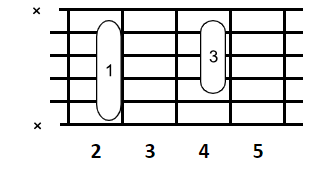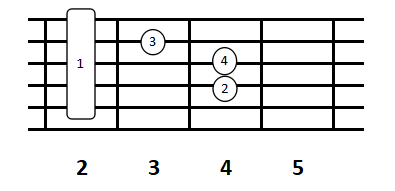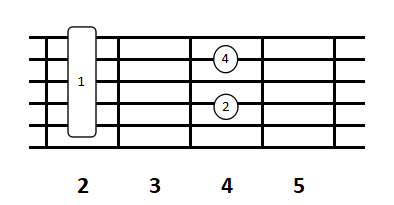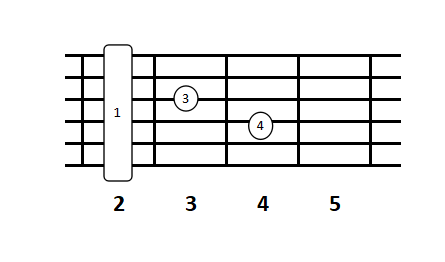This article is for people who:
・can’t hold B, Bm, B7, Fm, F7
・can’t hold the barre chord
In the previous article, I explained how to hold the F chord. (Links below)
Like the F chord, there are chords in which you press the 6th to 1st strings together with your index finger.
The ones that often appear are B, Bm, B7, Fm, and F7.
In this way, a chord played by pressing the 6th to 1st strings together with the index finger is called a barre chord.
Once you can play the F chord, you will be able to play the barre chord in the same way.
The tips on how to play it are the same as for the F chord, so if you can’t hold the F chord, I recommend that you refer to the article below before reading this article.
→How to hold the F chord/Tips
Now let’s explain the individual codes.
(1)B
Of the chords we will explain this time, this one may be the most difficult to grasp.
There are two ways to hold it, so whichever is easier to hold is fine.
i) First way to press

Use your index finger(1), middle finger(2), ring finger(3), and little finger(4).
This may make the sound easier.
The position of your index finger will be different because the F chord requires you to play up to the 6th string, while the B chord requires you to play up to the 5th string.
I think you should try changing the position of your index finger.
Avoid playing the 6th string.
ii) Second method of pressing

Use only your index and ring fingers.
This one requires you to press three strings with your ring finger, so it may be harder to produce a sound than i).
However, once you get used to pressing the chords, I think this method of pressing will make chord changes smoother.
If you try to play normally, your ring finger will hit the first string and you won’t hear the first string.
In order to make all the strings sound, you need to turn your ring finger quite a bit.
This first string is quite difficult to ring, but since it doesn’t have much of an effect even if it’s just the first string, I honestly think you can ignore the first string.
I think it’s a good idea to try changing the position of your index finger in this way as well.
(2)Bm

I think you can also hold Bm by paying attention to the same things as F.
Again, the position of the index finger is different from the F chord, so
I think it’s a good idea to find the position that produces the sound by varying the position of your index finger.
(3) B7

B7 also has almost the same precautions as Bm.
However, in the case of B7, you also need to press the 3rd string with your index finger.
For Bm, it would have been better if only the 5th and 1st strings were pressed with the index finger, but B7 doesn’t produce a clear sound unless the index finger hits all strings 1 to 5. .
The trick is to press the string with your index finger as close to the fret as possible.
Other than that, I think some of the points I wrote in the article about how to hold the F chord will become more important, so if you’re having trouble, you should check them again.
→How to hold the F chord/Tips
(4) Fm

If you look closely at Fm, you just remove the middle finger of the F chord.
However, this also requires more strings to be pressed with the index finger, so I think it is harder to produce a note than F.
The points I wrote in the article about how to hold the F chord are also important here, so if you have trouble, please refer to that.
(5) F7

F7 is just the little finger of the F chord removed.
This also means that you will have to press more strings with your index finger.
If you are having trouble, please also refer to the article on how to hold the F chord.
If you can learn the chords written in this article in addition to the chords introduced in other articles on this blog, you will have covered most of the common chords.
Also, if you learn to play the special chords that appear in each song, you should be able to play and accompany any song.
It may take some time to master the barre chord, but don’t rush and take your time.
So far, we have explained how to play chords.
At first, when you actually play the song, you’ll find that it stops at the point where the chord changes.
Therefore, in the next article, I will introduce how to practice chord changes.
<Next article>
iii) Tips and practice methods for changing guitar chords



